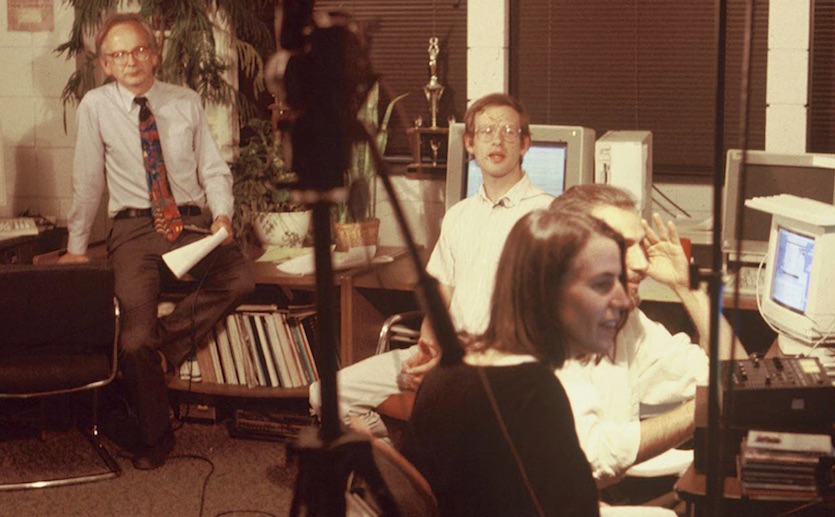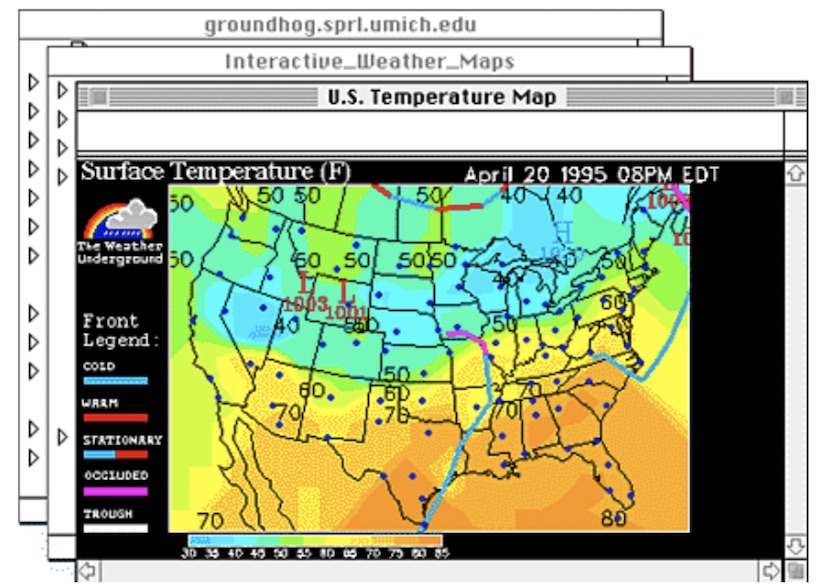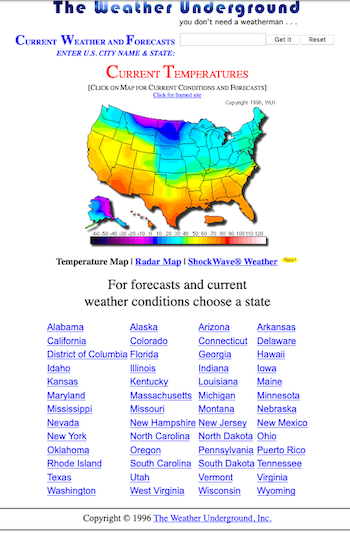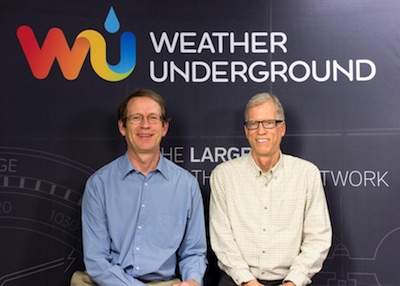| Above: Jeff Masters at the flight director’s station of the Hurricane Hunters’ Lockheed P-3 Orion before taking off towards Hurricane Hugo in September 1989. Image credit: NOAA. |
The first time Jeff Masters and I crossed paths was in an article—way back in 1995, during my days as a writer/editor at the University Corporation for Atmospheric Research (which manages the National Center for Atmospheric Research). I didn’t know Jeff at the time, but his name found its way into a writeup I did on innovations unfolding at the University of Michigan in collaboration with the UCAR-based program Unidata.
Perry Samson, now the Arthur F. Thurnau Professor of Atmospheric Science at the University of Michigan, was Jeff’s doctoral adviser in the 1990s. He inspired Jeff to launch the embryonic service that evolved into Weather Underground. Actually, “requested” may be a better word than “inspired.” As Perry described it for my article in the UCAR/NCAR internal newsletter, Staff Notes Monthly:
"I am not a morning person and was having trouble getting weather information organized in time for a 9:00 a.m. survey class. I asked a grad student, Jeff Masters, if there was some way I could get access to the data from our Unidata feed at home, then go to class and sound halfway intelligent."
Jeff’s initial effort, a menu-based text-only program called UM-Weather, quickly grew to 100,000 accesses a week after it drew attention on the embryonic Internet, which was then used mainly on college campuses and in military research. The next project, launched in 1992 by Perry, Jeff, and several other colleagues, with support from the National Science Foundation, was dubbed the Weather Underground—a name that paid tongue-in-cheek homage to the radical left-wing group that got its start in Ann Arbor in the 1960s. “Arguably, this was a terrible choice of names, and we heard that from many over the years,” recalled Perry in a recent email. “But, nonetheless, it stuck.”
 |
| Figure 1. Left to right: Perry Samson, Jeff Masters, Deborah Gibson and Jeff Ferguson produce an episode of an interactive, live, community-access cable television series called "Disaster in the Classroom" in 1994, one of their many experiments in K-12 interactive weather education prior to the commercial launch of Weather Underground. The show employed a puppeteer (and his puppet "Herbie") and a comedian (Walter Ego). The effort did not produce the hoped-for interaction with K-12 students, and was discontinued after one year. Image credit: Courtesy Jeff Masters. |
The next development was the creation of point-and-touch Internet graphics in BlueSkies, a client on the Mac-based nested-file Gopher protocol. Gopher was the state of the art in Internet design at the time, until the Mosiac web browser began gaining popularity in late 1994. BlueSkies was released on Gopher on Groundhog Day 1994 and was chosen later that year by Apple as one of 11 "Cool Tools for the Internet”.
 |
| Figure 2. BlueSkies, the Mac Gopher client developed by Alan Steremberg with help from Chris Schwerzler. Image credit: Perry Samson. |
In 1995, Weather Underground (WU) was spun off from these efforts as a private company. Just a few weeks after weather.com was licensed, WU was granted domain number 2000, meaning it was only the 2000th website on the entire Internet at the time.
 |
| Figure 3. The founders of Weather Underground in 1998, plus their first employee. Clockwise from top left: Dave Brooks, Alan Steremberg, Perry Samson, Chuck Prewitt, Mike MacDonald, Jeff Ferguson, Jeff Masters and Chris Schwerzler. Image credit: WU. |
A decade later, Weather Underground had grown into a thriving company. But co-founder Jeff was tiring of spending most of his time writing code, and was looking for a way to do more meteorology. Thus, “Dr. Jeff Masters’ WunderBlog” was born in April 2005. The timing was fortuitous. Just a few months later, the ferocious, unforgettable hurricane season of 2005 got under way, and Jeff found himself translating complex hurricane science for an audience that suddenly grew much larger than he’d expected.
Jeff will share his own perspective on his 14-year blogging tenure at WU in a post on Thursday, his last day with WU. Although Jeff is departing WU and IBM, Category 6 (the name we adopted in 2016 after a call for suggestions) will continue. You’ll be able to follow Jeff’s writing at Eye of the Storm, his new blog at Scientific American. I’m happy to report that Jeff plans to chime in here with comments and quotes from time to time, as well as with two guest posts later this year.
We are lucky all of Jeff’s blog posts are still online for the perusing—including the very first entry, “The 360-degree Rainbow,” which ran on April 14, 2005. You can find these vintage posts in two archives: one extending from the start of the blog to April 2017, and the other picking up from that point.
Jeff’s writing skill was evident long before he started blogging. His ten-part series “Hunting Hugo”, completed in the 1990s and originally published in Weatherwise magazine, is a tour-de-force guide to the terrifying experience of nearly losing one’s life while aboard a hurricane hunter flight—in this case, a P-3 flight that got caught in the maw of Hurricane Hugo. If you haven’t read “Hunting Hugo”, please do!
 |
| Figure 4. WU's homepage in November 1996. |
It's been the privilege of my career to work with Jeff on Category 6 over the past five years. I can’t imagine a more congenial or more supportive collaborator. We’ve regularly proofed each other’s posts and written many others in tag-team style, and I will sorely miss our regular debates over what to post when and which juicy tidbits to include. I’ve also appreciated Jeff’s willingness to hold those who would deny climate science to account—an ever-more-important task as humans continue to pump tens of billions of tons of greenhouse gases into the only atmosphere we have. Jeff’s service on the Climate Science Legal Defense Fund speaks volumes on his commitment to protecting climate researchers and keeping climate science in the public eye.
 |
| Figure 5. Jeff Masters and Bob Henson. Image credit: WU. |
Our outstanding team of Cat 6 moderators and I will continue to do our best to live up to the standards set by Jeff. We will work to keep the quality high, and to keep Category 6 a place where readers can share notes and perspective on the amazing atmosphere around us.
Thanks to Jeff’s dedication and generosity of spirit, this blog has inspired more than a few young people to embark on careers in science, including meteorology. I encourage you to check out the many tributes to Jeff that appear in the comment feed at his October 3 departure announcement. Here’s one more, from John Celenza, one of WU’s first employees, who is now at Saildrone:
“Jeff has been an inspiration to me since I was an undergrad at Penn State. His passion for climate and tropical weather is infectious. Jeff's presence has always been down-to-earth, often persuasive, but always rooted in science. As a result, he has performed an amazing educational service to the international community, including during and shortly after major weather disasters.”
I can’t think of a better person to get the last word in this post than Perry Samson:
“The Weather Underground was a collaboration of multiple people, including Jeff, but Jeff was notable in his unwillingness to relocate to the Weather Underground offices in San Francisco. He was committed to his life in Michigan and worked remotely as the company grew out west, becoming one of the most-read, if not the most-read, weather bloggers in the world. He remained highly creative as a programmer but also as a writer, taking complex processes and breaking them down into understandable stories. I am sure Jeff will flourish in his new position as blogger for Scientific American, and I won’t be surprised if he shows up as the occasional commenter on Cat 6 pages.
“For those who have not had the good fortune to meet Jeff, you should know that in addition to his talent at coding and writing he is simply a good man. He is very committed to his family and friends and has gone out of his way to give back to the communities he knows and communities affected by extreme weather. He has been and will continue to be an inspiration for how to conduct life with commitment and grace, and I wish him all the best in what’s next.”



